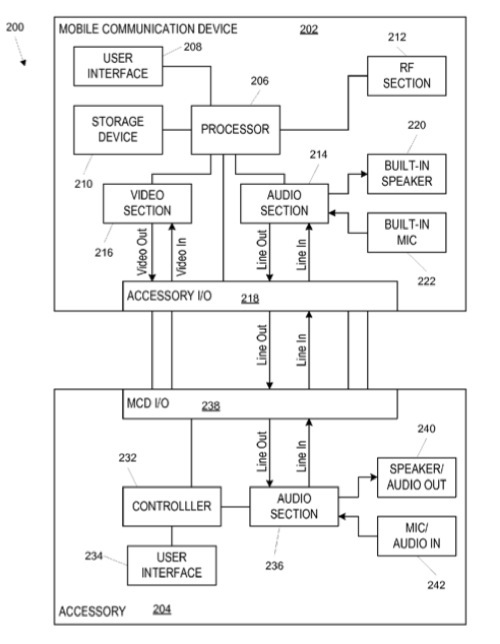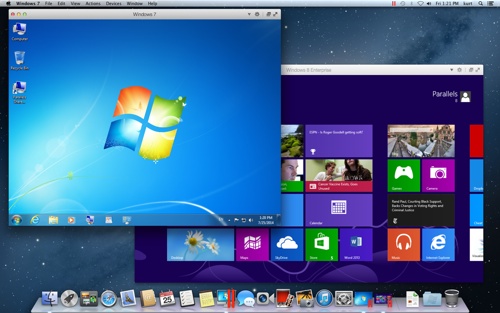An Apple patent (number 2010027643) has appeared at the US Patent & Trademark Office involving duplex audio for a mobile communication device and accessory.
Duplex audio is provided for a mobile communication device and an accessory. In some embodiments, the accessory can selectably operate in a duplex audio mode, concurrently sending audio to and receiving audio from the mobile communication device, or in another audio mode. In duplex audio mode, the accessory can enable its internal audio processing operations (e.g., echo cancellation) while the mobile communication device disables its corresponding internal operations or vice versa. The mobile communication device can control when the accessory transitions into and/or out of duplex audio mode. The inventor s are Jason Y. Yew and Lawrence G. Bolton.
Here’s Apple’s background and summary of the invention: “The present disclosure relates in general to mobile communication devices that interoperate with accessories and in particular to interoperation of a mobile communication device with an accessory to provide a duplex audio mode.
“Mobile communication devices, such as cellular phones, have become nearly ubiquitous. Some mobile communication devices, such as the iPhone.TM. (made by Apple Inc., assignee of the present application), can provide users a variety of services in addition to mobile telephone service; such services can include management and playback of media content (music, videos, audiobooks, photos, etc.); storage of personal data such as calendar, contacts, and notes; Internet access; and the ability to execute various application programs that the user may choose to download and install.
“Some mobile communication devices are designed to interoperate with various accessory devices (also referred to herein as accessories). For example, a mobile communication device can have a connector with a number of pins that support providing audio and/or video to an accessory, receiving audio and/or video from an accessory, providing serial communication to and/or from the accessory, providing power to and/or receiving power from the accessory, and so on. This connector can be docked or mated with a corresponding connector of an accessory, thereby allowing the exchange of various signals and data between the portable communication device and the accessory.
“Accessories can provide a number of different services or service enhancements in connection with a mobile communication device. For example, some accessories may include speakers to play audio content received from the mobile communication device and/or video display screens to display video content received from the mobile communication device. Some accessories may include a microphone and may provide audio input from the microphone to the mobile communication device, e.g., allowing the mobile communication device to act as a voice recorder. Some accessories may include video and/or still image cameras and may provide video and/or image data to the mobile communication device for storage and/or playback.
“Certain embodiments of the present invention relate to providing duplex audio operation between an accessory and a mobile communication device. The mobile communication device in some embodiments has a built-in speaker and microphone, allowing the device to be used as a telephone handset, voice recorder, audio player, or the like. The mobile communication device can incorporate echo cancellation processing between the built-in speaker and microphone. For example, to the extent that the built-in microphone picks up sounds emanating from the built-in speaker, the mobile communication device can cancel this contribution to the microphone signal, thus providing a cleaner sound experience. Some mobile communication devices are designed to automatically perform echo cancellation during a phone call or at other times when sound is concurrently being produced by the device’s speaker and detected by the device’s microphone.
“However, when the mobile communication device is docked with an external speaker, it can be more difficult for the mobile communication device to accurately perform echo cancellation, as the mobile communication device may lack information as to the audio characteristics of the external speaker (e.g., whether and how long any processing delay within the speaker might be). And in cases where the mobile communication device is also receiving audio input from an external source, the difficulty of accurate echo cancellation is increased. Further, an external device that has both its own speaker and microphone might perform its own echo cancellation, in which case it would not be desirable for the mobile communication device to duplicate the echo cancellation.
“Certain embodiments of the present invention provide improved interoperability of a mobile communication device with a speaker accessory, including echo cancellation. In one embodiment, when a mobile communication device that is docked with a speaker accessory detects the beginning of a phone call (e.g., when a call is received or placed), it can notify the speaker accessory and disable its own internal echo cancellation operations. The speaker accessory, which can also have a microphone, can enable its echo cancellation operations, providing clear audio to the parties to the call.
“In other embodiments, the coordination of echo cancellation between the mobile communication device and the accessory can be applied in phone calls as well as other situations. For example, a number of situations can arise where an accessory is receiving audio signals from the mobile communication device and concurrently delivering audio signals to the mobile communication device, sometimes referred to herein as a “duplex” audio mode. In any such situation, the mobile communication device and the accessory can coordinate the responsibility for various audio processing operations, such as echo cancellation. In one embodiment, the mobile communication device can signal to the accessory to indicate when the accessory should enter or exit duplex audio mode. When in duplex audio mode, the accessory can enable its internal audio processing operations (e.g., echo cancellation) while the mobile communication device disables its corresponding internal operations (or vice versa). When the accessory transitions to a mode other than duplex, the mobile communication device can re-enable its own internal audio processing operations and the accessory can disable its corresponding internal operations.
“In further embodiments, the accessory may provide user input controls allowing the user to remotely operate the phone functionality of the mobile communication device. For example, the accessory may be able to instruct the mobile communication device to answer or disconnect a call, to place a call to a selected number, to display voice mail notifications or content, or the like.”


![[MD1] O’Reilly: Official Be Publisher](https://www.mactech.com/wp-content/themes/Extra/images/post-format-thumb-text.svg)

